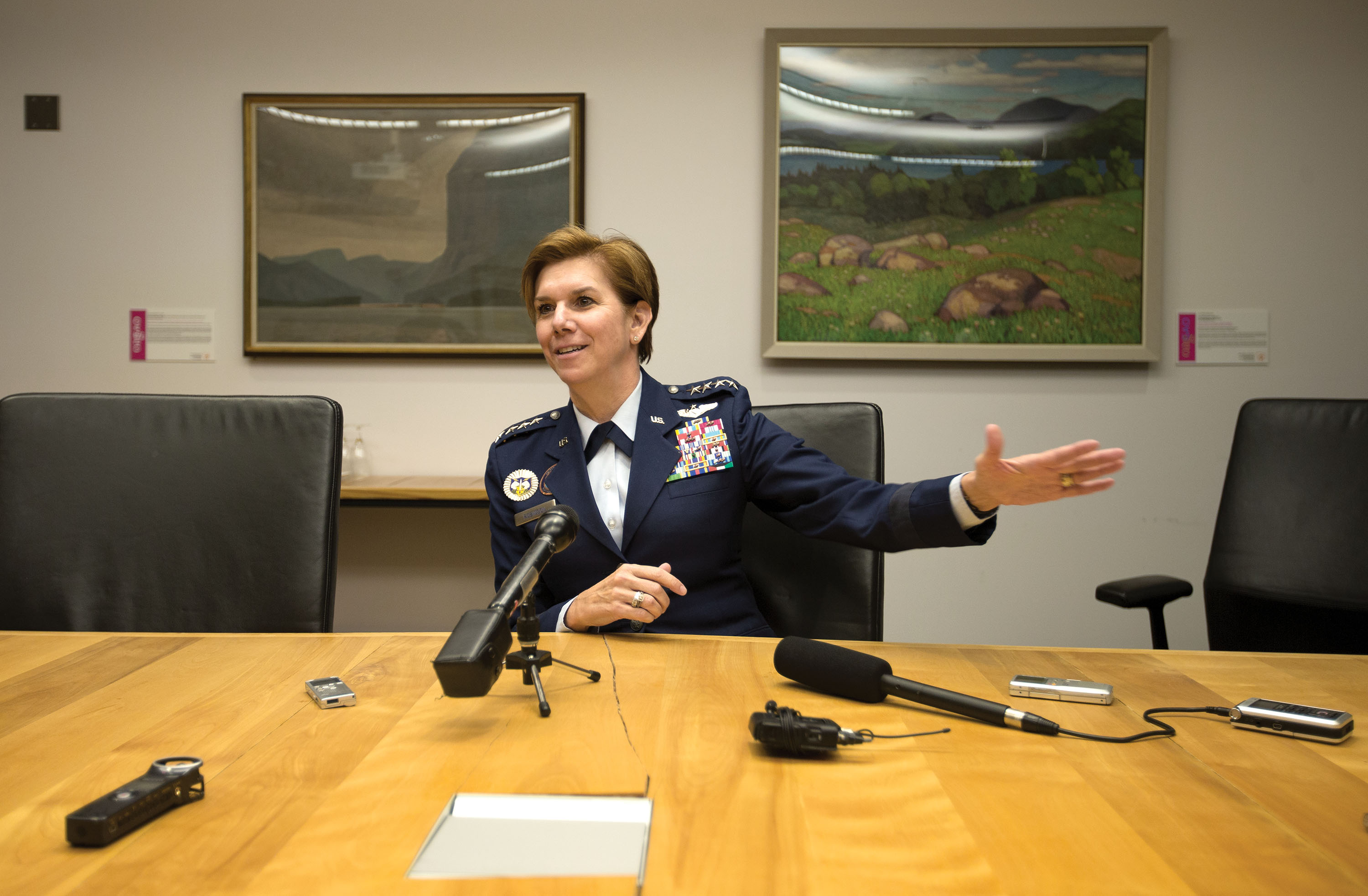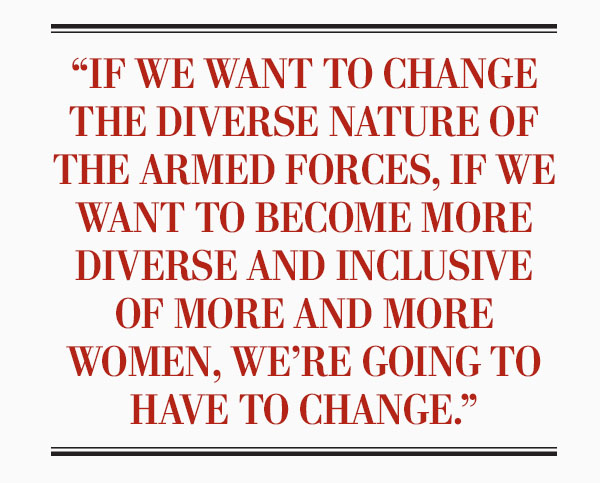
Perhaps the best moment of February’s annual Conference of Defence Associations Institute (CDA) symposium in Ottawa came on the second day when an officer cadet named Melissa Sanfacon of Kingston’s Royal Military College took the microphone and confronted the chief of the defence staff before a room full of brass, former brass, bureaucrats, diplomats and academics.
The CDA is an umbrella group of military and veteran associations. The principal subject matter for the two-day conference seemed heady enough: Great Powers, World Order—and Canada’s Defence Policy Review.
Norad’s commander, U.S. General Lori Robinson, had addressed morphing threats and opaque intent among enemies old and new. Political studies professor Kim Nossal of Queen’s University had described an “insurgent” U.S. administration that is “intent on dismantling the global order.” A panel had talked of the potential “unravelling” of the 68-year-old North Atlantic Treaty Organization.
But Officer Cadet Sanfacon had more fundamental things in mind and she wasn’t about to let General Jonathan Vance walk away unscathed.
Vance had just delivered a 40-minute treatise on the state of the Canadian Armed Forces, replete with promises to boost the enrolment of women over the next decade and curb the preponderance of sexual misconduct in the ranks.
Sanfacon wanted to know just what boosting women’s enrolment would entail. “When you speak about getting more women into the force, I’m wondering if at the same time there’s been any thought put to kit that can be actually useful and more suited to women in operations,” Sanfacon said.
She cited body armour and rucksacks, in particular, pointing to the fact the U.S. military has started issuing kit specifically designed for women while the Canadian Forces have not. The frame of her rucksack, she noted, was issued in 1982 for what was then the average soldier: a five-foot, 11-inch, 175-pound male. Sanfacon is four-foot, 11-inches and 100 pounds.
“It’s not quite functional or practical,” she said, to spontaneous applause from the audience.
“Listen,” Vance replied, “I hear you. I’m five-seven; I’ve been chaffing against this stuff my whole career, too.
“My body armour rides up to here,” he added, laying his hand under his upturned chin. Then the head of the Canadian military paused a moment before adding, to the delight of all: “Look, you’re right. Next question.”
He then repeated his endorsement of the cadet’s perspective. Vance confirmed that he had asked Lieutenant-General Paul Wynnyk, the commander of the army, to follow up with the cadet.
Vance has vowed to boost the proportion of women in the military by one percentage point a year until it reaches 25 per cent from the current 14.
“Diversity and increasing the number of women in the Canadian Armed Forces is not just the right thing to do, it’s a matter of institutional survival,” Vance told the conference. “We have to become more diverse.”

Reaching overall recruiting targets depends heavily on increasing female recruitment, Auditor General Michael Ferguson reported in November. But he noted the CAF had not implemented special employment-equity measures to help it along. About half the women in the Canadian military are pigeon-holed into six of the Forces’ 100-plus occupations: resource management support clerks, supply technicians, logistics officers, medical technicians, nursing officers and cooks.
Vance told the conference the military has to change the way it attracts, retains and parts with people.
“If we want to change the diverse nature of the armed forces, if we want to become more diverse and inclusive of more and more women, we’re going to have to change,” he said.
“There was a time when we could just sit back and say ‘come and join us.’ That doesn’t work anymore.”
The military is facing multiple human resources issues that can’t help his case. More than 300 soldiers in Kuwait to assist in the fight against ISIS learned in December they were to lose a tax break, a form of danger pay, worth at least $1,500 a month. A resolution was reached after a defence department review, with some soldiers receiving the benefit and others not. But the affair was just short of a public-relations disaster.
This came as many departing soldiers faced crippling delays in the transition between their military paycheques and their veterans’ pensions. CBC reported that the pension backlog peaked at some 13,000 files last year.
Post-traumatic stress injury remained at critical levels in the years after Afghanistan, and military-related suicides continued to mount—an “enormous challenge,” Vance described the issue, adding that half those who killed themselves were not in treatment, and they should have been.
Meanwhile, a Statistics Canada survey of 43,000 CAF members found that the rate of sexual assault in Canada’s military during the previous 12 months was almost double that of workers in the general population, 1.7 per cent compared to 0.9 per cent.
While Vance has made Operation Honour, his strategy aimed at eliminating sexual impropriety, a priority of his tenure, he told the conference that broader human-resources issues require a comprehensive long-range approach focused on what he called “the journey—from the point we attract you, through your service and beyond.
“Our conditions of service are largely built for one type of person—a person who’s fully fit and [ready] to deploy, is a generalist in most cases and a specialist when we need them to be a specialist,” he continued. “That may not work in the future. Our conditions of service may very well need to change.”
He said members need more freedom to move back and forth between regular service and the reserves, between part-time and full-time, between restricted and unrestricted employment.
So the military is considering “all manner of conditions of service, to provide a more flexible career path” and modernize its personnel-management policies. “The ultimate objective must be, and always will be, to produce the armed forces necessary for Canada to conduct the operations that the government wants us to do now and in the future,” said Vance.
Specifically, Vance promised to introduce “as immediately as we can” a new military organization, a “transition unit” commanded by a general officer who will institute a “professionalized process” to guide and care for outgoing members, ensuring they leave the Armed Forces as well and prepared as possible.
“We want to make certain that veterans have every chance at thriving,” Vance told a scrum with reporters. “A successful transition, a successful, professional administrative departure from the Armed Forces, is just as important as the successful administrative arrival into the Armed Forces.
“Too many people were on their own—on their own to read the regulations; on their own to figure out what it is that they had to do. And that is compounded by a lateness of a pension cheque or something that they should have known but didn’t because they didn’t happen to read that particular paragraph of that particular volume that’s that thick. People need support coming into the Armed Forces and they need support going out. And they need it even more if they’re wounded.”
Already almost a year into his three-year tenure, the CDS would not, however, be pinned down on a time frame, acknowledging that a rollout could be as long as two years away. “I want to start it as soon as I can,” he said.

Advertisement












